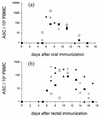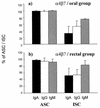Differences in immune responses induced by oral and rectal immunizations with Salmonella typhi Ty21a: evidence for compartmentalization within the common mucosal immune system in humans
- PMID: 9826335
- PMCID: PMC108711
- DOI: 10.1128/IAI.66.12.5630-5635.1998
Differences in immune responses induced by oral and rectal immunizations with Salmonella typhi Ty21a: evidence for compartmentalization within the common mucosal immune system in humans
Abstract
Based on the concept of the common mucosal immune system, immunization at various inductive sites can induce an immune response at other, remote mucosal surfaces. The immune responses elicited through rectal and oral routes of antigen delivery were compared with respect to (i) measurement of antibody responses in serum and various external secretions of the vaccinees and (ii) characterization of the nature and homing potentials of circulating antibody-secreting cells (ASC). Specific ASC appeared in the circulation in 4 of 5 volunteers after oral and 9 of 11 volunteers after rectal immunization with Salmonella typhi Ty21a. The kinetics, magnitude, and immunoglobulin isotype distribution of the ASC responses were similar in the two groups. In both groups, almost all ASC (99 or 95% after oral or rectal immunization, respectively) expressed alpha4 beta7, the gut homing receptor (HR), whereas L-selectin, the peripheral lymph node HR, was expressed only on 22 or 38% of ASC, respectively. Oral immunization elicited a more pronounced immune response in saliva and vaginal secretion, while rectal immunization was more potent in inducing a response in nasal secretion, rectum, and tears. No major differences were found in the abilities of the two immunization routes to induce a response in serum or intestinal secretion. Thus, the rectal antigen delivery should be considered as an alternative to the oral immunization route. The different immune response profiles found in various secretions after oral versus rectal antigen administration provide evidence for a compartmentalization within the common mucosal immune system in humans.
Figures





References
-
- Abitorabi M A, Mackay C R, Jerome E H, Osorio O, Butcher E C, Erle D J. Differential expression of homing molecules on recirculating lymphocytes from sheep gut, peripheral, and lung lymph. J Immunol. 1996;156:3111–3117. - PubMed
-
- Berlin C, Berg E L, Briskin M J, Andrew D P, Kilshaw P J, Holzmann B, Weissman I L, Hamann A, Butcher E C. α4β7 integrin mediates lymphocyte binding to the mucosal vascular addressin MAdCAM-1. Cell. 1993;74:185–195. - PubMed
-
- Brandtzaeg P. Role of J-chain and secretory component in receptor-mediated glandular and hepatic transport of immunoglobulins in man. Scand J Immunol. 1985;22:111–146. - PubMed
-
- Butcher E C, Picker L J. Lymphocyte homing and homeostasis. Science. 1996;272:60–66. - PubMed
Publication types
MeSH terms
Substances
Grants and funding
LinkOut - more resources
Full Text Sources
Medical
Miscellaneous

